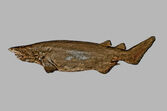Defining Features[]
Echinorhiniformes have many defining features. You can identify Echinorhiniformes by their enlarged, thorn-like denticles scattered over the body, after all the group's scientific name means "hedgehog shark". Other features include five pairs of gill slits, two spineless dorsal fins, located far back on the body, a lack of an anal fin, and ovoviviparous.
Habitat and Range[]
Echinorhiniformes appear to be spottily — though widely — distributed, inhabiting deep water from cool temperate to tropical zones of the eastern Atlantic, Pacific, and Indian oceans. For example Bramble sharks typically haunt moderately to very deep waters — from 36 to 2,950 feet.
Fisheries Conservation and Concern[]
Echinorhinus brucus is a small fishery with minor commercial fishing yet considered a gamefish. Echinorhinus cookei is also a small fishery with minor commercial fishing.
Closest Relatives[]
Example Species in Echinorhiniformes[]
Prickly Shark[]
Echinorhinus cookei[]

Defining Features: Short snout and stout body

Range & Habitat: West Coast of USA, some islands of Hawai'i, West coast of Ecuador, top of Australia, middle of Indonesia.
IUCN Concern: DD (Data Deficient)
Bramble Shark[]
Echinorhinus brucus[]
Defining Features: Short snout and generally stout body.
Range & Habitat: Present everywhere in the ocean except the eastern pacific.
IUCN Concern: EN (endangered)
References[]
https://www.fishbase.de/summary/Echinorhinus-brucus.html
https://www.iucnredlist.org/species/41801/2956075
https://www.iucnredlist.org/species/41802/68622003
https://www.fishbase.de/summary/Echinorhinus-cookei.html